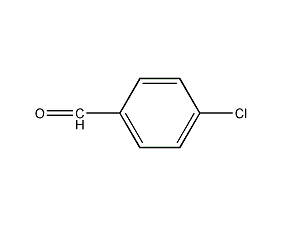
Structural formula
| Business number | 02QW |
|---|---|
| Molecular formula | C7H5ClO |
| Molecular weight | 140 |
| label |
p-chlorobenzaldehyde, p-chlorobenzaldehyde |
Numbering system
CAS number:104-88-1
MDL number:MFCD00003379
EINECS number:203-247-4
RTECS number:CU5076000
BRN number:385858
PubChem number:24854064
Physical property data
1. Properties: colorless to light yellow flake crystals or powder
2. Density (g/mL, 25℃): 1.196
3. Relative density (25 ℃, 4℃): 1.19661
4. Melting point (ºC): 48
5. Boiling point (ºC, normal pressure): 214
6. Refractive index at room temperature (n25): 1.55561
7. Refractive index: 1.5552
8. Flash point (ºC): 87
9. Crystal phase standard claims heat (enthalpy) (kJ·mol-1): -146.4
10. Autoignition point or ignition temperature (ºC): 395
11. Vapor pressure (mmHg, 20.2ºC): Undetermined
12. Saturated vapor pressure (kPa, ºC ): Undetermined
13. Heat of combustion (KJ/mol): Undetermined
14. Critical temperature (ºC): Undetermined
15. Critical Pressure (KPa): Undetermined
16. Log value of oil-water (octanol/water) distribution coefficient: Undetermined
17. Explosion upper limit (%, V/V): Undetermined
18. Lower explosion limit (%, V/V): Undetermined
19. Solubility: Easily soluble in ethanol, ether and benzene, soluble in water and acetone.
Toxicological data
Acute toxicity: Rat oral LD50: 1575mg/kg; Rat inhalation LC: >473mg/m3/4H; Mouse oral LD50: 1400mg/kg;
Ecological data
It is extremely harmful to water and toxic to fish. Do not let the product enter the water body.
Molecular structure data
1. Molar refractive index: 37.90
2. Molar volume (cm3/mol): 113.0
3. Isotonic specific volume (90.2K ): 288.2
4. Surface tension (dyne/cm): 42.2
5. Dielectric constant:
6. Dipole moment (10-24cm3):
7. Polarizability: 15.02
Compute chemical data
1. Reference value for hydrophobic parameter calculation (XlogP): None
2. Number of hydrogen bond donors: 0
3.�Number of �� bond acceptors: 1
4. Number of rotatable chemical bonds: 1
5. Number of tautomers: None
6. Topology Molecular polar surface area 17.1
7. Number of heavy atoms: 9
8. Surface charge: 0
9. Complexity: 95.1
10. Number of isotope atoms: 0
11. Number of determined atomic stereocenters: 0
12. Number of uncertain atomic stereocenters: 0
13. Determine the number of stereocenters of chemical bonds: 0
14. Uncertain number of stereocenters of chemical bonds: 0
15. Number of covalent bond units: 1
Properties and stability
Avoid contact with oxidants, air, and light.
Storage method
Store in a cool, ventilated warehouse. Keep away from fire and heat sources. should be kept away from oxidizer, do not store together. Store away from air and away from light. Equipped with the appropriate variety and quantity of fire equipment. The storage area should be equipped with emergency release equipment and suitable containment materials.
Synthesis method
(1) by parachlorine Obtained by chlorine hydrolysis of toluene: Add p-chlorotoluene and phosphorus trichloride to the reaction pot, and heat it to 155℃, pass in chlorine gas. Control the temperature at160-170℃, pass chlorine to the calculated amount to obtain chlorinated liquid. Add it to concentrated sulfuric acid while stirring, and stir at room temperature 5h. Let stand and separate into layers. Remove the layer and put it into ice water for crystallization. Cool to Filter below 5℃. The filter cake is washed with ice water to obtain a crude product, which is distilled under reduced pressure and collected108-111℃ (3.33kPa) fraction is Get the finished product.
(2) p-chlorotoluene manganese dioxide oxidation method: first add p-chlorotoluene to the reaction pot, then add 70% Sulfuric acid, slowly add manganese dioxide below 70℃. After the addition is completed, react for 0.5h, and then steam distillation. In addition, p-chlorobenzaldehyde can also be obtained by oxidizing p-chlorotoluene with air.
Purpose
Used as pharmaceutical and dye intermediates, in the manufacture of fenalol, aminobutyric acid, etc.


